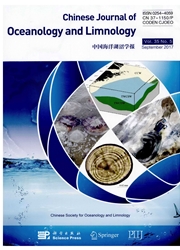

 中文摘要:
中文摘要:
Chondrus 是广泛地为食物使用的经济地重要的红藻;生物化学的目的。它早开发为文化是关键的;幼苗繁殖。我们选择了四分芽胞;是的果孢子 ofChondrus ocellatus 为文化的实验的例子,感应;处于实验室状况释放,试图理解早发展 ofC。ocellatus;在幼苗生产适用。MatureC。ocellatus 在 Qingdao 被收集,中国,从 11 月到 2004 年 12 月。在配偶体以后;tetrasporophyte 被刷;与消毒海水洗了,海藻的材料为 20 min 在 1.5% KI 被对待,然后被弄干让 1h 刺激释放孢子。在一夜间释放的孢子以后,它在足媒介是有教养的,在 18 ° C 孵化了, 10 ± 2 μ m ol/(m [2 ]· s [1 ]) 在 12 ∶ 1 2h (光:黑暗) 。观察;在显微镜下面记录被执行。早发展的连续观察两个都显示出那四分芽胞;果孢子类似于对方。一般来说,早发展的三个舞台被显示出是分割,圆盘形的外壳;幼苗舞台。到部门舞台,最明显的特征是增加房间数字;在圆盘形的外壳舞台期间,圆盘形的外壳有三维的轴,;它开始区分了房间的类型进二:基础房间;顶端的房间;到幼苗舞台,几像隆起出现在圆盘形的外壳上;形成的少年幼苗。果孢子;四分芽胞展出了包括了部门舞台的一个类似的发展过程,圆盘形的外壳舞台;幼苗舞台。
 英文摘要:
英文摘要:
Chondrus is an economically important red algae widely used for food and biochemical purpose. It early development is crucial for the culture and seedling propagation. We chose tetraspores and carpospores of Chondrus ocellatus as examples for experiment of the culture, induction and release in laboratory condition, aiming to understand early development of C. ocellatus and to apply in seedling production. Mature C. ocellatus were collected in Qingdao, China, from Nov. to Dec. 2004. After the gametophyte and tetrasporophyte were brushed and washed with sterilized seawater, the algal materials were treated in 1.5% KI for 20 min, then were dried for lh to stimulate the releasing of spores. After the spores released overnight, it were cultured in PES medium, incubated at 18 ℃, 10±2 μmol/(m^2.s^1) in 12:12h (light: dark). The observation and recording under microscope were carried out. Continuous observation of the early development showed that both tetraspore and carpospore are similar to each other. In general, three stages of the early development were shown being division, discoid crust and seedling stages. To the division stage, the most obvious feature was the increasing of cell number; during the discoid crust stage, the discoid crust had a three-dimensional axis, and it began to differentiate into two types of cells: the basal cells and the apical cells; and to the seedling stage, several protuberances-like appeared on the discoid crusts and formed juvenile seedlings. Carpospores and tetraspores exhibited a similar development process that included division stage, discoid crust stage and seedling stage.
 同期刊论文项目
同期刊论文项目
 同项目期刊论文
同项目期刊论文
 期刊信息
期刊信息
